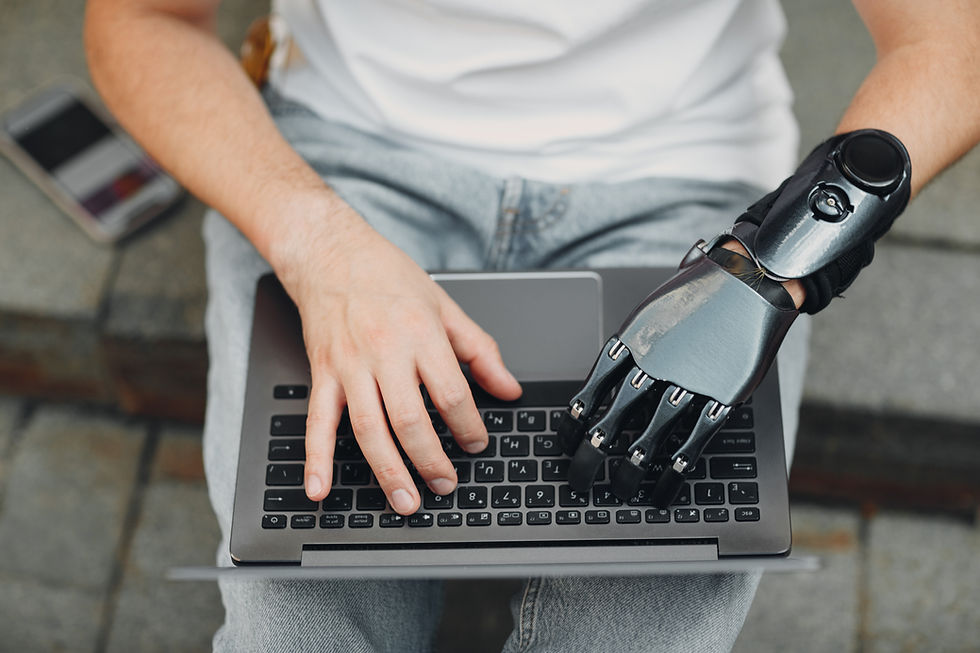Digital Accessibility: The Next Frontier of Disability Rights
- katherineslewis
- Jul 29, 2022
- 4 min read
By Katherine Lewis, Diversability

Blue gradient box with white quote box and image of Katherine Lewis. Top: Digital Accessibility: The Next Frontier of Disability Rights. Bottom: logos for Diversability and Women Enabled International.
The world is increasingly relying on the internet for daily life, and so is the disability rights movement. Activists and allies alike use digital platforms and media to share ideas, start movements, and enact real change in the effort for a more equitable world. At the same time, the digital space has become the subject of activism, as the need to make the online world accessible has grown in importance. Digital activism and accessibility often work in tandem, mutually strengthening their effectiveness and impact.
What is Digital Accessibility?
Digital accessibility refers to the design, development, and practices that allow disabled people and others with access needs, including, for instance, language barriers, to consume information and interact with websites, mobile applications, and other digital technology. In the United States, digital accessibility is governed by a set of laws, including the Americans with Disabilities Act (ADA). At the international level, it is governed by a collection of standards and guidelines developed by the W3C Web Accessibility Initiative, also known as the Web Content Accessibility Guidelines 2.0 (WCAG). Although protected by anti-discrimination law, the vast majority of digital spaces are not accessible to disabled users. In fact, just roughly 2% of websites meet WCAG standards for digital accessibility. But the tides are beginning to shift, thanks to vocal activists and allies using social media and other platforms to start conversations, spread awareness, and demand action.
Digital Accessibility As Activism
In the wake of the COVID-19 pandemic, an already heavy reliance on digital platforms grew exponentially. As the mass inequities disproportionately impacting the disabled became glaringly apparent, advocates took to social media to spread messages of inclusion, equity, and justice. A number of disability-related hashtags like #CripTheVote and #MyDisabledBodyIsWorthy went viral, enabling advocates to grow their reach and impact.
The use of the digital space increased quickly and became a central focus of disability activism, and advocates embraced the opportunity to highlight long-standing inequities and access barriers that had been largely ignored before. Actions like enabling captions in virtual meetings, including image descriptions in social content, and having sign language interpreters at online conventions have made their way into mainstream conversations. Tasks as simple as using camel case (capitalizing the first letter of each word) in hashtags became opportunities for activism. The addition of accessible digital tasks has transformed workspaces and commercial industries. Even professional industries have been impacted. As an accessibility expert and digital designer myself, I’ve noticed that before the pandemic and the growth of activism that arose from it, digital accessibility was often left out of design curriculum and strategy development within organizations. Now we’re starting to see that change. Institutions are starting to add accessibility as part of their training pipelines and organizations are incorporating it into their planning. It’s still a small percentage, but I’m encouraged by what I’m seeing.
Digital Accessibility as a Civic Issue
As the discourse surrounding digital accessibility continues to grow, the benefits and the potential for harm are also increasingly important factors to consider. Many organizations and companies are beginning to recognize the benefits of embracing accessibility — reduced legal risk, stronger brand presence, improved customer experiences, and more. However, the motivation for action (particularly in business) has largely focused on avoiding lawsuits rather than recognizing opportunities for growth, community, and empowered clients/customers. While it may seem like a minor detail, it’s a significant distinction in the fight for disability justice. Framing digital accessibility in the context of avoiding lawsuits alone has the potential to uphold ableist narratives and further harm the movement towards meaningful inclusion.
In an NBC article about problematic website overlays, activist Holly Scott-Gardner explained: “[Focusing on lawsuits] capitalizes on this fear that disabled people are out there to sue you and make your life difficult …. It furthers this really horrible view of disabled people that we’re literally out there to get money and that we just use our disabilities for that.”
Cases like this have prompted an intentional shift in the way activists and accessibility professionals frame the digital accessibility conversation. The reminders that “accessibility is about people” and “digital accessibility is essential to equity and inclusion in the modern world” are commonly used to re-center action and alleviate harm. The hope is that establishing digital accessibility as the civil rights issue it is will lessen negative assumptions and prompt more organizations to do their part.
Progress Through Balance
The movement towards a more accessible internet is only going to grow. And, as it does, the continued need to balance activism with intentional action will grow with it. Activism is essential to access, but without accountability, actions have the potential to do more harm than good. With activists and allies working together, we have the opportunity to expand and empower the disability rights movement alongside the initiative for an accessible web. I am confident that with increased commitment to uphold and expand digital access and equity for all, we can create the inclusive and accessible future we deserve. . . . This piece was originally published in Women Enabled International’s blog Rewriting the Narrative (RtN).
About the author: Katherine Lewis (she/her) is an inclusive business strategist, accessibility consultant, and disability advocate. She approaches business strategy from the lens of intersectional access — because creating spaces and experiences that are accessible for ALL people is the key to building a truly human-centered business. In addition to her work in digital accessibility, she is the Head of PR and Content for the Diversability team.



Comments